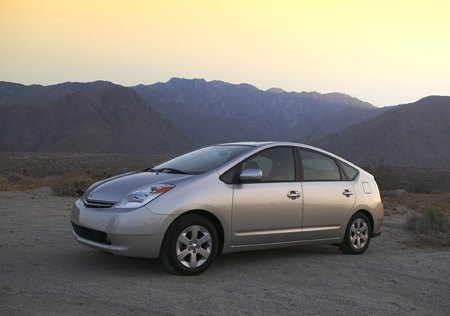PHEV's Rule!
Toyota should be all over the plug-in hybrid electric vehicle (PHEV) concept like stink on bumwad. Perhaps their unintentionally non-commercial experience with the all-electric RAV4 EV put them off the concept. They probably figured that a mainstream motor requiring nightly recharging would be as popular as a compact Cadillac diesel with 8-4-0 cylinder deactivation. Still, Toyota’s beginning to get with the program— as are Ford, DaimlerChrysler, George Bush and every green-leaning op-ed columnist. Appropriately enough, the change of heart’s down to a small group of Californians long derided as rich hippies with too much time on their hands.
These much-maligned Left Coasters are engineers and entrepreneurs rallying around an e-banner called CalCars.org . They’ve been known to spend an extra $10k to $12k per car to add plug-in capability to their hybrid transportation. They plug in their Prius at night, charge a special set of drive batteries, roll out of bed and commute and/or run errands entirely on amps. Their modified Prius won’t fire up its internal combustion (IC) engine until they’re doing 35, provided they stay light on the throttle.
Obviously, a PHEV isn’t going to help drivers with an 80-mile, 80-mph commute. But it works for me. Once every weekday, I loop around the local post office, gym, hardware store, Radio Shack, dentist or whatever. Give me a range of 35 in-town electric miles and I’m there. If I deplete my plug-in hybrid’s batteries, I’ll simply go to gas and carry on.
The PHEV eliminates the fatal flaw of electric cars: limited range. If your commute is reasonably short, plug the puppy in at work and motor back home with a full tank of volts. You probably won’t need to fire up the IC engine until the weekend trip to Vegas. Based on the American driver’s typical daily runs (they average seven miles each), a PHEV could deliver 100 mpg or more. People who ride Vespas do half as well.
Toyota’s standard it-won’t-work whine: the Prius’ nickel-metal hydride (NiMH) battery puts out lots of power for a short time. It wouldn’t survive daily deep discharge/recharge cycles. In fact, Japanese and Euro-spec Prii have an electric-only switch, so owners can move their hybrid to the other side of the street [in accordance with local parking laws] without having to start them up, apparently. That said, a Prius won’t even travel a mile on its standard internal battery. Bottom line: a useful plug-in hybrid requires a lead acid “energy battery,” which are notoriously heavy and short-lived.
At first, CalCars’ hackers circumvented this limitation by installing a secondary set of lightweight lead-acid batteries, originally intended for electrical bicycles. They’ve since moved on to lighter, longer lasting (and more expensive) lithium-ion batteries. The secondary batteries don’t put out a whole lot of power, but it’s enough to chug a light car along for an hour or two. Of course, you need controllers and wiring to make it all work. But as they say, if it was easy, everybody would be doing it.
Spare batteries in the trunk, homemade wiring, thousands of dollars per car for electronics, a week’s DIY work… of course the PHEV makes no sense. But I suspect Toyota, Mercedes or even GM could make it a lot more sensible. Hey, don’t tell me a society that can develop the Ionic Breeze air purifier and sell expensive pills to reduce stress-induced belly fat can’t invent better batteries…
Yes, I know: electricity comes from “somewhere" and arrives complete with its own environmental costs. But one huge factor in electricity’s favor— and why it will supplant both gasoline and hydrogen as the power source for future cars— is that amps and volts already have a perfectly good transportation and supply infrastructure: power lines, household wiring and extension cords. No other source of alternative energy starts with such an obvious advantage.
Best of all, electricity comes from a wide variety of existing, plentiful, independent, domestic sources: coal, nuclear, natural gas, hydro, garbage, even solar and wind power. Worse comes to worst, I could even recharge my plug-in hybrid vehicle’s batteries by hooking it to my Exercycle, since it’s actually an alternator that provides variable resistance when I pedal. Try that with diesel, fuel cells, hydrogen, fusion or Kryptonite. Clearly, the PHEV is a shockingly good idea.
I'm the automotive editor of Conde Nast Traveler and a freelancer for a variety of other magazines as well. Go to amazon.com and read more about me than you ever wanted to know if you do a search for either of my current books, "The Gold-Plated Porsche" and "Man and Machine." Been a pilot since 1967 (single- and multi-engine land, single-engine sea, glider, instrument, Cessna Citation 500 type rating all on a commercial license) and I use the gold-plated Porsche, a much-modified and -lightened '83 911SC, as a track car.
More by Stephan Wilkinson
Latest Car Reviews
Read moreLatest Product Reviews
Read moreRecent Comments
- Lou_BC Well, I'd be impressed if this was in a ZR2. LOL
- Lou_BC This is my shocked face 😲 Hope formatting doesn't fook this up LOL
- Lou_BC Junior? Would that be a Beta Romeo?
- Lou_BC Gotta fix that formatting problem. What a pile of bullsh!t. Are longer posts costing TTAC money? FOOK
- Lou_BC 1.Honda: 6,334,825 vehicles potentially affected2.Ford: 6,152,6143.Kia America: 3,110,4474.Chrysler: 2,732,3985.General Motors: 2,021,0336.Nissan North America: 1,804,4437.Mercedes-Benz USA: 478,1738.Volkswagen Group of America: 453,7639.BMW of North America: 340,24910.Daimler Trucks North America: 261,959


































Comments
Join the conversation
Stephan, as you likely remember, last year Csaba Csere sent Barry Winfield in the direction of one of the key proponents of plug-in hybrids in California. Knowing that Barry is a man who believes that we humans need to take care of the earth (and endangered species) with more care, he didn't set to do a hatchet job. He's too good a journo for that. But the guy he talked to, never wanted to allow him to drive a plug-in hybrid and was evasive as can be. There's a fellow I met who is a member of the Seattle Electric Vehicle Association, who has built a plug-in hybrid version of his Prius. He claims 100 miles-per-gallon from his car; and I believe him. However, he admitted in a private conversation with me - as opposed to what he told a journo with the Seattle Times looking for a story - that he tricks the system so it keeps runnng beyond the point when the IC (internal combustion) engine should switch on. It's admittedly hard on the batteries - think decreased life - and negates the Toyota warranty. The jury on plug-in hybrids is still out.
Terry, I'm not surprised Fritz Kramer (which is who I think it was) didn't let Barry drive the car, or that the guy in Seattle has to fiddle with the car to make it run. These are all individual enthusiasts doing their best to keep from electrocuting themselves, and I think all it shows is that the jury is still out on homemade PHEVs. All they're trying to do, and they'll be the first to admit it, is to prod somebody who knows what they're doing into undertaking the project rather than them--somebody like Toyota or Ford. Beats the shit outa me, as Bedard used to say, how anybody can say the concept is a lousy idea.